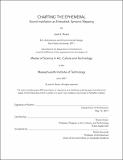| dc.contributor.advisor | Renée Green. | en_US |
| dc.contributor.author | Rivera, José A. (José Alejandro) | en_US |
| dc.contributor.other | Massachusetts Institute of Technology. Department of Architecture. | en_US |
| dc.date.accessioned | 2017-09-15T14:22:14Z | |
| dc.date.available | 2017-09-15T14:22:14Z | |
| dc.date.issued | 2017 | en_US |
| dc.identifier.uri | http://hdl.handle.net/1721.1/111270 | |
| dc.description | Thesis: S.M. in Art, Culture and Technology, Massachusetts Institute of Technology, Department of Architecture, 2017. | en_US |
| dc.description | This electronic version was submitted by the student author. The certified thesis is available in the Institute Archives and Special Collections. | en_US |
| dc.description | Cataloged from student-submitted PDF version of thesis. "June 2017." | en_US |
| dc.description | Includes bibliographical references (pages 101-105). | en_US |
| dc.description.abstract | This thesis examines the ways in which sound installations aesthetically provide spatial encounters with a location, emphasizing ephemerality, multiplicity, and relationality. Informed by experimental sound practices, spatial studies, and theories in critical cartography, current conceptions of the sound map are challenged. Though the origins of the sound map date back to the 1970s soundscape movement, modern sound maps are online repositories of location recordings that are geo-referenced and navigated with the use of a digitized, aerial map. A critical analysis of sound maps argues for a more embodied, sociocultural, and dynamic spatio-sonic experience. Through lenses of sound, space, and cartography, this thesis interrogates such topics as: attentive listening, the notion of "sound art", location recording and phonography, acoustic ecology, the soundscape, resonance, the relationship between inscription, vibration, and transmission, site-specificity, map making and map use, bioregionalism, meteorology and the history of weather maps, radar, spaces of representation, proxemics, architecture, and embodiment. Through these different interrogations, the sound installation is understood as an aural cartographic process that suggests a multi-layered way of knowing about a location through sound. The organized, spatio-sonic encounter is an embodied synsonic mapping in practice -- a constant, fleeting, and relational process that engages the shifting circumstances of the world. | en_US |
| dc.description.statementofresponsibility | by José A. Rivera. | en_US |
| dc.format.extent | 105 pages | en_US |
| dc.language.iso | eng | en_US |
| dc.publisher | Massachusetts Institute of Technology | en_US |
| dc.rights | MIT theses are protected by copyright. They may be viewed, downloaded, or printed from this source but further reproduction or distribution in any format is prohibited without written permission. | en_US |
| dc.rights.uri | http://dspace.mit.edu/handle/1721.1/7582 | en_US |
| dc.subject | Architecture. | en_US |
| dc.title | Charting the ephemeral : sound installation as embodied, synsonic mapping | en_US |
| dc.title.alternative | Sound installation as embodied, synsonic mapping | en_US |
| dc.type | Thesis | en_US |
| dc.description.degree | S.M. in Art, Culture and Technology | en_US |
| dc.contributor.department | Massachusetts Institute of Technology. Department of Architecture | |
| dc.identifier.oclc | 1003322678 | en_US |
